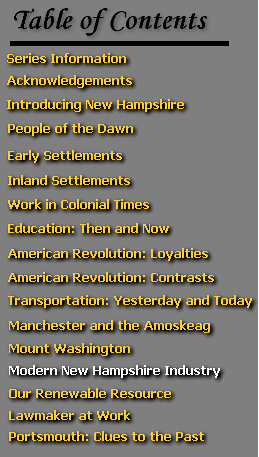Note:
Our NH was produced in 1976, much of the information in this episode is
dated and many of the industries mentioned have since closed, relocated
or been purchased. In the web section of this page, you will find links
to current business and industry resources. A utilization strategy for
using this episode, might be to have your students update the episode.
SUMMARY
 Before
there were machines, everything a person needed was made by hand. People
had fewer clothes and other material goods, but what they did have was
of sturdy quality and made by hands that took pride in their creation. Before
there were machines, everything a person needed was made by hand. People
had fewer clothes and other material goods, but what they did have was
of sturdy quality and made by hands that took pride in their creation.
The invention of machinery
and factory production brought a sudden change to this life of simplicity.
People began to have more goods, have choices in how they lived their lives,
have chances to try new jobs. But they also endured long hours of work
and low pay. In the 1920s, partly because of worker demands for better
conditions, the textile and shoe industries in New Hampshire began to lose
their place in the national market. In 1935, the Amoskeag Mills were finally
forced to close their doors. What would take their place?
From the decline of shoe
manufacturing and the collapse of the textile mills, New Hampshire learned
a valuable lesson about the dangers of concentrating its resources too
heavily in a limited area. When New Hampshire industry began to recover
after the depression of the 1930s, it blossomed with a variety of new industries
which manufactured a variety of usable products. This diversification was
a healthy change for our state, which offered a strong economy and steady
employment for New Hampshire people.
New Hampshire industry today
remains diversified and provides career options that were never before
possible. Sanders Associates in Nashua
provides electronic equipment; Digital Equipment Corporation in Salem (note:
Digital Equipment was bought by Compaq in 1998) makes a line
of computers. Ingersoll-Rand in Nashua
manufactures heavy machinery for making plastic molding and environmental
pollution control systems. Miniature Precision Ballbearings in Lebanon
makes bearings for navigational equipment. Phas-R Laser Company develops
custom lasers. Anheuser-Busch in Merrimack brews beer. The Felton
Brush Company in Manchester manufactures brushes, while New
England Homes in Portsmouth produces pre-fab homes. This diversified
yet highly specialized group of industries requires workers who are well
trained in a particular field. Some tasks call for patience and a delicate
touch; others call for dexterity and concentration. Some industries employ
workers with skills of metal cutting, precision-tooling and welding; still
others need workers to produce hand-set and custom items. Indeed, the skill
of the colonial craftsman exists in an altered form.
Training for such specialized
tasks is acquired in a variety of ways, including attending technical institutes
and on-the-job training. In all cases, students gain marketable skills
that benefit the whole state. New Hampshire products and the skills of
New Hampshire workers, in fact, benefit the entire nation--even other nations.
Today's workers are more likely to be involved in and dependent upon a
much larger world than colonial workers. This kind of interdependence gives
new meaning to the concepts of worldwide cooperation and accommodation.
New Hampshire industry is part of a network of industry that spans the
globe.
OBJECTIVES
1. To explore some
of the present-day industries that contribute to New Hampshire's economic
welfare.
2. To begin to appreciate
the intricacy and skills involved in modern New Hampshire industry.
3. To catch a glimpse
of various career options available to a modern-day work force.
4. To consider some
of the changes in the essence of "manufacturing" from past to present.
5. To consider some
of the benefits of "diversification" in industry.
6. To examine the
educational purpose of vocational-technical schools in New Hampshire.
7. To gain an awareness
of the interdependency of modern industry by examining New Hampshire industry
as a part of an international network of trade.
8. To develop an appreciation
and a sense of pride in New Hampshire by surveying its products and considering
their value to the nation's economy.
PRE-VIEWING ACTIVITIES
1. Review the Industrial
Revolution and its effect on New Hampshire's people.
2. Discuss manufacture,
diversification, and other vocabulary (listed under "Words To Know").
3. Talk about the
types of careers that you think are available to people who work in New
Hampshire.
4. In small groups,
make lists of the types of industries presently operating in New Hampshire.
Compare these lists to industries examined in the lesson.
POST-VIEWING ACTIVITIES
1. Discuss the following:
-
How has the word "manufacture"
changed in meaning from colonial times?
-
How have machines changed our
lives? What have we lost? Gained?
-
How has New Hampshire diversified
its industries? How does diversification in industry help a state's economy?
-
What careers are presently available
in New Hampshire?
-
How is New Hampshire's economy
dependent on other states? Other countries? How are their economies dependent
on New Hampshire products?
2. Make arrangements
to visit some local industry--large or small (shoe mill and private cobbler,
for example).
3. Hold a debate on
the value of mass production versus small quantity production and keep
score of the losses and gains of each method.
4. Write an essay
comparing colonial crafts and craftsmen to modern-day products and producers.
5. Make a collection
of the variety of ways in which New Hampshire producers advertise their
products, using local newspapers, magazines, and other media.
6. Develop a photographic
display of pollution as a byproduct of modern industry.
7. Visit an old New
Hampshire mill that is still in operation, interview the manager to discover
how production has changed over the years.
8. Develop a skit
which explores why people go on strike, how they arbitrate, why some strikes
are illegal, and other related topics.
9. Examine some questionable
work practices of the past such as child labor, unsanitary food processing,
unequal pay for equal work. Consider if, and how, these practices are controlled
today.
10. Hold a debate
on (a) to unionize or not to unionize; and (b) the value of industry before
and after the Industrial Revolution.
11. Develop an assembly
line which will culminate in an actual finished product. Consider the effect
of piecemeal work on the laborer.
12. Start a folder
of career options available to a modern day work force. Consider which
careers might not exist in New Hampshire and where a person might have
to live in order to pursue such a career.
13. Develop a skit
which depicts "on-the-job-training" for some specific task.
14. Invite several
apprentices to class to talk about the value of their experiences to their
new profession.
VOCABULARY
-
vocational-technical school
-
on-the-job training
-
flamecutter
-
soldering
-
computer
-
titanium
-
pollution
-
forklift
-
ballbearing
-
navigational
-
conveyor belt
-
laser
-
prefab
-
union
-
foundation
-
manufacture
-
strike
-
welder
-
Industrial Revolution
-
breadline
-
mechanized
-
loom
-
beermeister
-
steam whistle
-
radar systems
-
textiles
-
diversify(ied)
-
missiles
-
mass-produced
-
circuit boards
-
precision products
-
interdependence
-
apprentice
PLACES TO KNOW
-
Sanders Associates, Nashua
-
Anheuser-Busch, Merrimack
-
Digital Equipment Corp., Salem
-
Felton Brush Co., Manchester
-
Ingersoll Rand, Nashua
-
New England Homes, Portsmouth
-
Miniature Precision Ballbearinqs,
Lebanon
-
Amoskeag Mills, Manchester
-
Phas-R Laser Company, New Durham
PLACES TO VISIT
-
Any of the above
-
Mall of New Hampshire
-
Any local industry
-
Voc-Tech schools in your area
ARTICLE
By DAVID WYSOCKI
Associated Press Writer
CONCORD - Wages averaged
$3.50 a day, but gasoline was plentiful. Eight out of 10 of the 450,000
people living in New Hampshire were born in the state. Four of every 10
acres were farmland and one-third of fruit was New Hampshire grown.
This year was 1929.
The statistics and assessment
of New Hampshire life were gleaned from a chance find at a yard sale -a
50-year- old Industrial Survey of New Hampshire.
"The findings of this survey
are encouraging and support our faith in New Hampshire's future," wrote
Frank Comerford, president of Grafton Power Co., for which the survey was
conducted in 1929. "We trust that the information contained herein will
justify continued confidence in New Hampshire,: he said.
The information contained
in the report's faded pages includes the following:
- Agricultural production
was "efficient," with 37 percent of the fruits and vegetables consumed
in the state grown locally.
- 90 percent of the electricity
generated in the state was hydroelectric.
- There was no tax on the
income of industrial corporations.
- 80 percent of the residents
were native-born.
- 40 percent of the land
was farmland.
- More businesses were moving
into the state than out.
- Unemployment was low.
- Passenger train service
thrived.
- There was little highway
traffic, and few highways.
Glaring differences exist
between the New Hampshire of 50 years ago and the New Hampshire of today,
not the least of which are the drastic reduction in farmland, increased
dependence for food and population growth.
And businesses here will
be quick to note that the absence of a tax on industrial income is long
gone. The business profits tax is the state's single largest source of
income.
Agriculture officials say
the state now is dependent on other areas for more that 85 percent of its
fruits and vegetables.
Officials cite to reasons
for the pendulum swing.
More people live in New Hampshire,
prompting higher demand for food. And the land needed to grow the food
has been gobbled up at an alarming rate either to house the people or build
stores for them.
The 40 percent farmland in
1925 has decreased to 9.5 percent and is still falling, said Vincent Peterson
of the state Agriculture Department.
The survey says farms covered
2,262,084 acres in 1925. They cover 506,000 acres last year, with only
110,000 acres of harvested cropland.
In the survey year 80 percent
of New Hampshire residents were New Hampshire natives; today, planners
estimate nearly 58 percent of the state's residents were born elsewhere.
Population figures show tremendous
growth in southern New Hampshire. Derry's population has more than tripled
since 1929, rising from 5,570 to 16,861; Nashua's has more than doubled;
rising from 30,100 to 66,000; Salem, which has less than 5,000, now has
28,000.
But the population in the
North Country city of Berlin has decreased from 19,235 to 14,600.
Others showed mostly modest
increases - Manchester from 84,000 to 93,000; Concord from 22,600 to 31,800;
Portsmouth from 15,000 to 22,300; Dover from 13,500 to 23,000; Laconia
from 11,400 to 16,100.
The state's population has
nearly doubled.
The largest single category
of employment was in the textile industry, which accounted for 28 percent
of the industrial output of the state.
The survey said a 54-hour
work-week was "general" in industry throughout the state, with an average
wage of $3.50 a day. Many residents now make more than that in a hour.
However there are similarities
between the New Hampshires of 1929 and today. First, there is still no
personal income tax nor general sales tax.
A similar survey today would
still show more businesses moving into the state than moving out. And still
remaining are the low, but rising, crime rate; low unemployment; relatively
pollution-free air and water; and few of the problems of other states.
WEB RESOURCES
|




